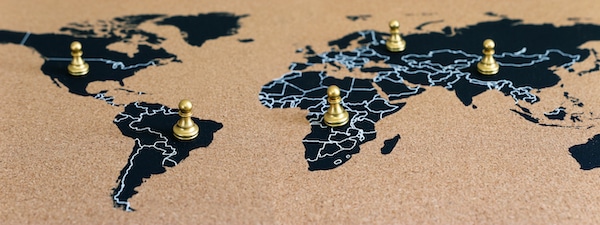Russia, Ukraine, and the Battle for the World Order
by Nick Giambruno via International Man

The rules-based international order…
The liberal international order…
The international community…
You undoubtedly have heard the media and politicians use these strange and vague phrases.
They are describing the current world order or architecture for international political relations between countries.
World orders are nothing new. It’s how the big global powers have set the rules of the game for centuries.
On a smaller scale, it’s similar to when the most powerful criminal groups in a given city—like mafias and street gangs—come together and agree on how to divide their activities and neighborhoods among themselves.
Sooner or later, though, these agreements always break down. Then, there is a violent power struggle until the criminal groups reach a new agreement that reflects the new balance of power.
A similar dynamic is at play with the most powerful countries and world orders.
Wars among the most powerful countries typically lead to a breakdown and restructuring in the world order.
Here is a brief overview of some of the most recent world orders. You can think of them as epochs or distinctive periods in history.
The Current US-Led World Order (1945 to Today): The Allies crafted the current world order in the aftermath of WWII with the US as the leader. It features institutions like the United Nations, the World Bank, and the International Monetary Fund—all of which are in the US. While the US is dominant, the other two large powers—Russia and China—have seats at the table.
Treaty of Versailles (1919 to 1939): The victors of WWI created this world order, which featured institutions like the League of Nations. It broke down after Germany and Japan tried to make their own world order during WWII.
Congress of Vienna (1814 to 1914): The military defeat of French Emperor Napoleon I led to this world order. It enshrined the British as the dominant global power. The Congress of Vienna formed the basis for European international politics until the outbreak of WWI in 1914.
The US-Led World Order is Getting Shaky
The godfather of geopolitical theory was British strategist Sir Halford Mackinder. Mackinder developed a general theory that connected geography with global power. Today, military strategists in the US, Russia, and China study his teachings.
Mackinder argued that dominating the Eurasian landmass—Asia and Europe together—was the key to being the leading global power.

Zbigniew Brzezinski, the renowned American geopolitical strategist, echoed Mackinder on the importance of Eurasia in his book The Grand Chessboard: American Primacy and Its Geostrategic Imperatives.
“Ever since the continents started interacting politically, some five hundred years ago, Eurasia has been the center of world power. A power that dominates ‘Eurasia’ would control two of the world’s three most advanced and economically productive regions… rendering the Western Hemisphere and Oceania geopolitically peripheral to the world’s central continent. About 75% of the world’s people live in ‘Eurasia,’ and most of the world’s physical wealth is there as well, both in its enterprises and underneath its soil. ‘Eurasia’ accounts for about three-fourths of the world’s known energy resources.”
A single power or coalition that controls the resources of Eurasia would be an unstoppable global superpower… one that could credibly challenge and potentially upend the current US-led world order.
For decades, preventing that from happening has been the central—but largely unspoken—goal of US geopolitical strategy.
This is the Big Picture context that we should view recent and more historical events in—NATO expansion, the Russian invasion of Ukraine, the wars in Afghanistan and Iraq, the rise of China, etc.
The primary Eurasian geopolitical challengers to the US-led world order are Russia, China, and to a lesser degree Iran.
While they resent US dominance, Russia and China have a seat at the table in the current world order. They have permanent seats at the UN Security Council and are members of core international organizations like the IMF, the World Bank, the WTO, and so forth.
Russia and China are also onboard with the horrible global agendas for Covid restrictions, vaccine passports, digital identities, social credit systems, and central bank digital currencies.
That’s why, at this point, it doesn’t seem that Russia and China want to flip the board and create their own world order—as Germany and Japan tried to do during WWII. Instead, they seem to want to work within the current global order to give themselves a bigger seat at the table.
Whether they can manage that balancing act without triggering a war with the US is the $64,000 question.
Here is one sure thing. The US is bungling the big picture geopolitical strategy. From the US perspective, the optimal strategy would be to pit Russia and China against each other. Instead, US actions are pushing China and Russia closer together, which creates a credible challenge to the US-led order.
Here’s the bottom line. We are approaching the end of an era. The current world order is getting shaky and could soon fall apart. There is already a dangerous power struggle going on right now, and it could turn catastrophic if it comes to an open war between the big powers.
I’m not trying to be a referee and say who the good and bad guys are. Frankly, I think they are all bad guys, not unlike a collection of crime families dividing up the spoils of a given city.
I’m just trying to objectively describe the Big Picture so I can make better-informed investment decisions in what could be the most volatile time in anyone’s life.
Reprinted with permission from International Man.